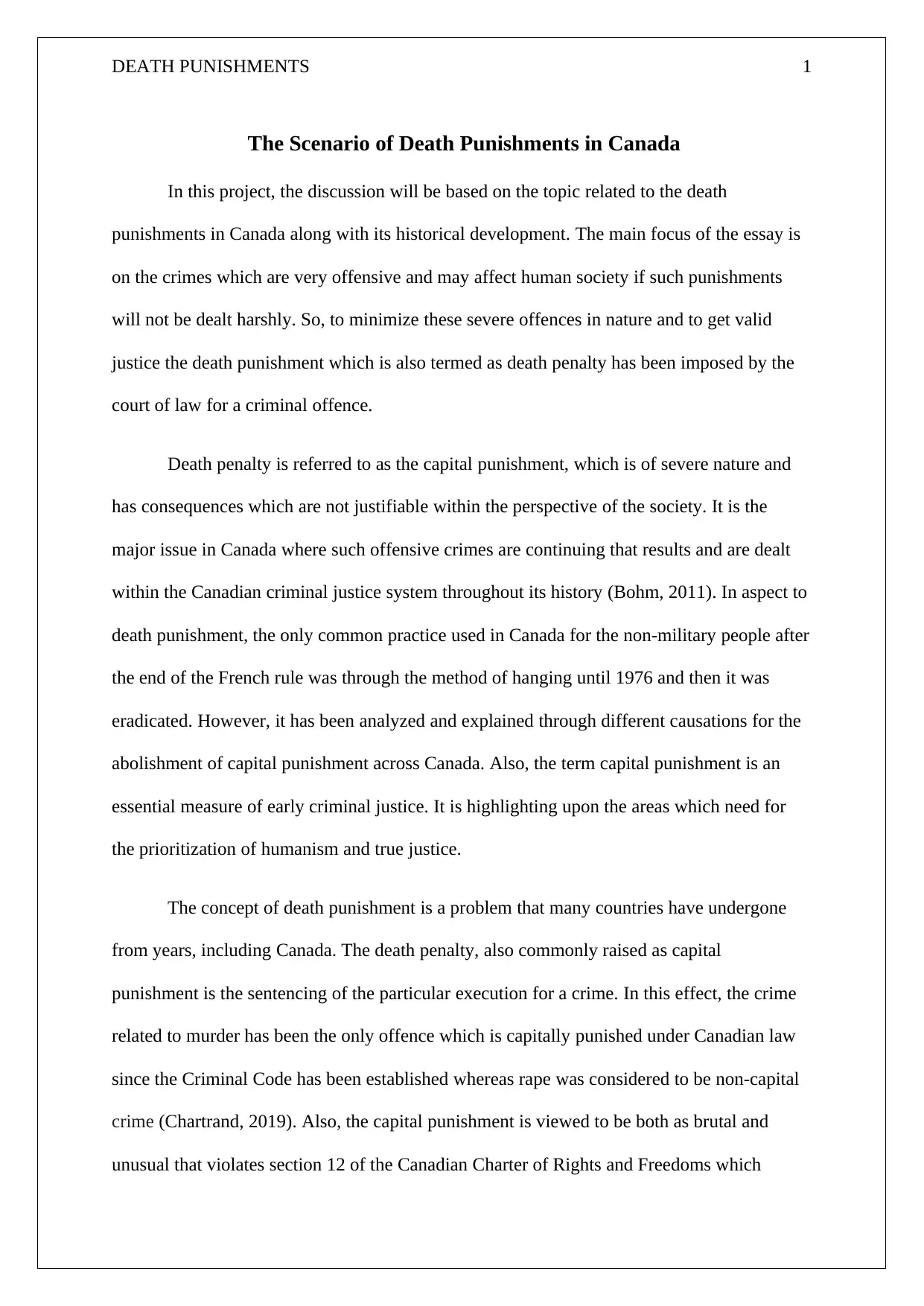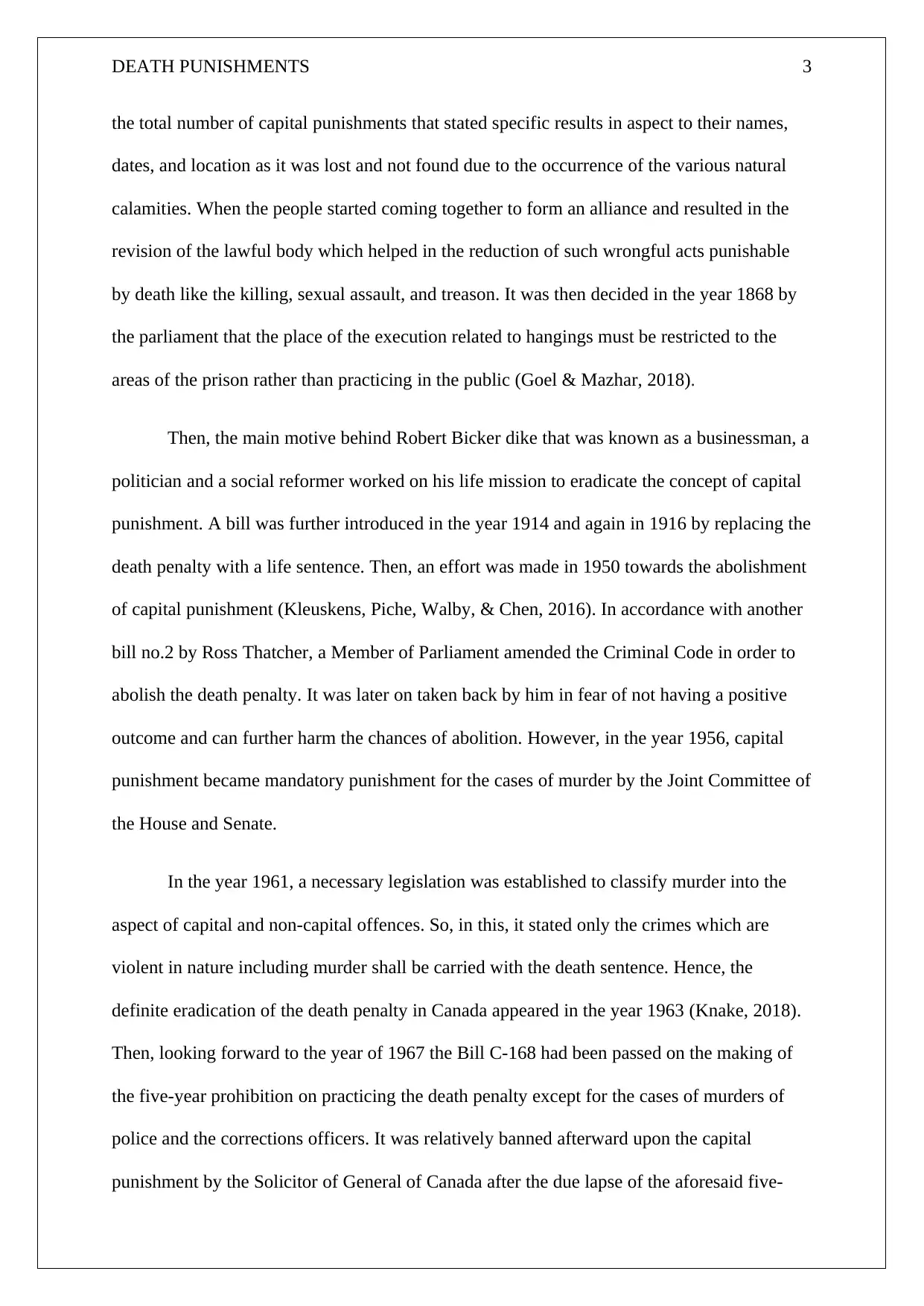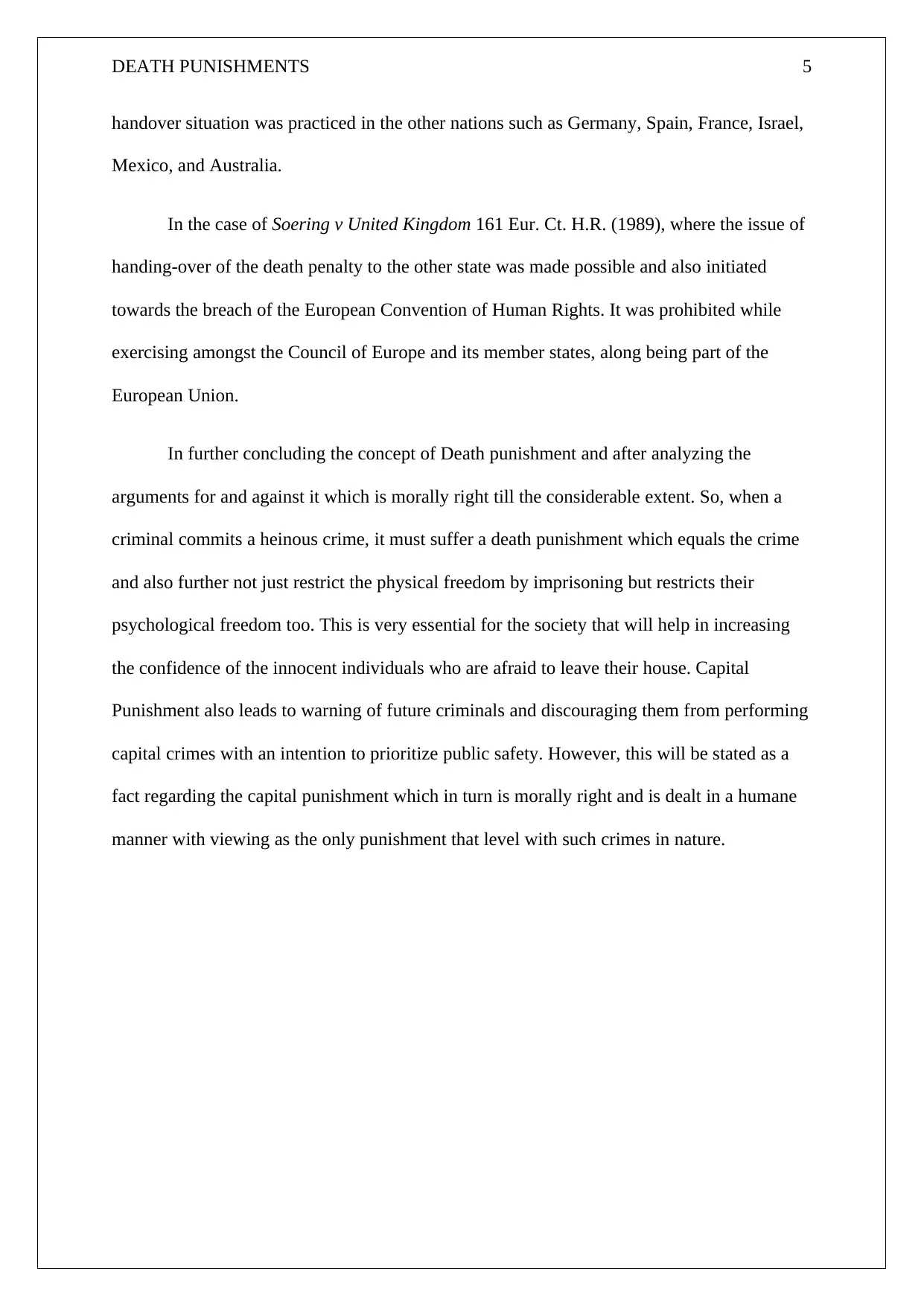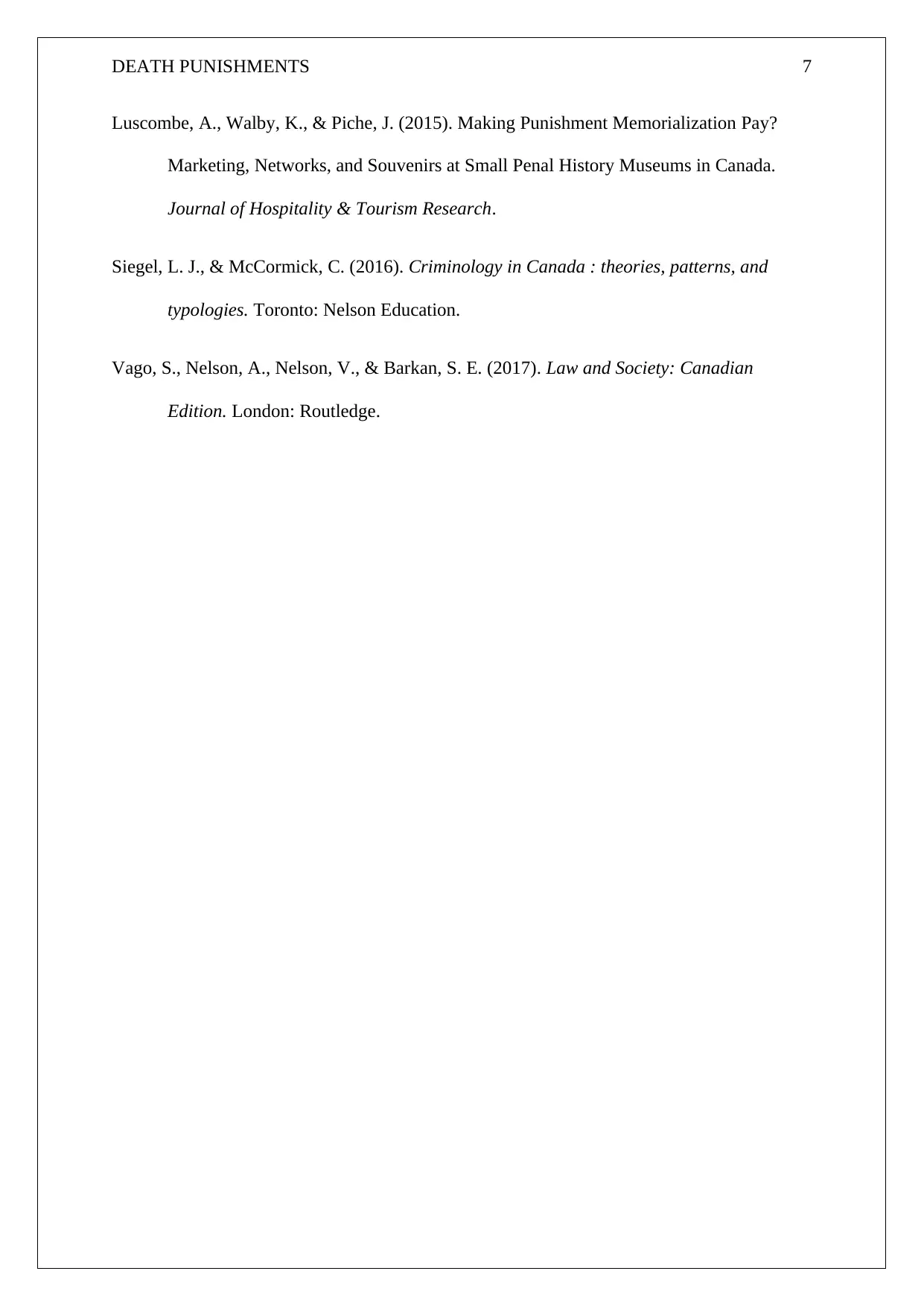Death Punishments in Canada: Historical Context and Legal Analysis
VerifiedAdded on 2022/11/24
|8
|2144
|123
Essay
AI Summary
This essay delves into the historical development of death punishments in Canada, tracing its evolution from the French rule to its eventual abolishment. It examines the crimes for which capital punishment was imposed, the methods used, and the key figures and events that shaped the legal landsca...

Running Head: DEATH PUNISHMENTS 0
DEATH PUNISHMENTS IN CANADA
DEATH PUNISHMENTS IN CANADA
Paraphrase This Document
Need a fresh take? Get an instant paraphrase of this document with our AI Paraphraser

DEATH PUNISHMENTS 1
The Scenario of Death Punishments in Canada
In this project, the discussion will be based on the topic related to the death
punishments in Canada along with its historical development. The main focus of the essay is
on the crimes which are very offensive and may affect human society if such punishments
will not be dealt harshly. So, to minimize these severe offences in nature and to get valid
justice the death punishment which is also termed as death penalty has been imposed by the
court of law for a criminal offence.
Death penalty is referred to as the capital punishment, which is of severe nature and
has consequences which are not justifiable within the perspective of the society. It is the
major issue in Canada where such offensive crimes are continuing that results and are dealt
within the Canadian criminal justice system throughout its history (Bohm, 2011). In aspect to
death punishment, the only common practice used in Canada for the non-military people after
the end of the French rule was through the method of hanging until 1976 and then it was
eradicated. However, it has been analyzed and explained through different causations for the
abolishment of capital punishment across Canada. Also, the term capital punishment is an
essential measure of early criminal justice. It is highlighting upon the areas which need for
the prioritization of humanism and true justice.
The concept of death punishment is a problem that many countries have undergone
from years, including Canada. The death penalty, also commonly raised as capital
punishment is the sentencing of the particular execution for a crime. In this effect, the crime
related to murder has been the only offence which is capitally punished under Canadian law
since the Criminal Code has been established whereas rape was considered to be non-capital
crime (Chartrand, 2019). Also, the capital punishment is viewed to be both as brutal and
unusual that violates section 12 of the Canadian Charter of Rights and Freedoms which
The Scenario of Death Punishments in Canada
In this project, the discussion will be based on the topic related to the death
punishments in Canada along with its historical development. The main focus of the essay is
on the crimes which are very offensive and may affect human society if such punishments
will not be dealt harshly. So, to minimize these severe offences in nature and to get valid
justice the death punishment which is also termed as death penalty has been imposed by the
court of law for a criminal offence.
Death penalty is referred to as the capital punishment, which is of severe nature and
has consequences which are not justifiable within the perspective of the society. It is the
major issue in Canada where such offensive crimes are continuing that results and are dealt
within the Canadian criminal justice system throughout its history (Bohm, 2011). In aspect to
death punishment, the only common practice used in Canada for the non-military people after
the end of the French rule was through the method of hanging until 1976 and then it was
eradicated. However, it has been analyzed and explained through different causations for the
abolishment of capital punishment across Canada. Also, the term capital punishment is an
essential measure of early criminal justice. It is highlighting upon the areas which need for
the prioritization of humanism and true justice.
The concept of death punishment is a problem that many countries have undergone
from years, including Canada. The death penalty, also commonly raised as capital
punishment is the sentencing of the particular execution for a crime. In this effect, the crime
related to murder has been the only offence which is capitally punished under Canadian law
since the Criminal Code has been established whereas rape was considered to be non-capital
crime (Chartrand, 2019). Also, the capital punishment is viewed to be both as brutal and
unusual that violates section 12 of the Canadian Charter of Rights and Freedoms which

DEATH PUNISHMENTS 2
further stated that every person has the right not to be subjected to brutal and uncommon
treatment or sentencing. In the year 1976, death penalty was eliminated from the Criminal
Code of Canada. It was then replaced back with initiating of a compulsory life sentencing
without the possibility of parole for 25 years for all first-degree murders (Vago, Nelson,
Nelson, & Barkan, 2017).
In the year 1645, the Andre Bernard held the post of the executioner in New France
but it was not permanently controlled until 1648. It was also stated about a military drummer
who was stopped at the French military area, was sentenced to death for the crime of buggery
by the local Sulpician priests. It involved one of the member of the Jesuits in this drummer’s
life case where he was given an alternative relief by accepting the position of New France’s
first permanent executioner (DeKeseredy & Dragiewicz, 2016). The drummer’s original
name had not been revealed in the historical records. It was being very popular regarding the
role of the executioner in New France as because of the male criminal who was sentenced to
death but on the other hand, could have spared his life if had agreed to take the initiative for
the offered job. Also, the executioner’s life could have saved if he would have married her.
There were several cases were examined relating to the same cases which included Jacques
Daigre who was sentenced to death for theft in 1665 and Jean Corolere saved a prisoners life
named Francoise Laurent by marrying her.
In analyzing the context of British North America’s historical background with
relation to the capital punishment was started in the year 1749, where a sailor known as Peter
Cartcel had unlawfully got into a ship while injuring two men and killed one person. This
matter was brought in front of the Captain’s Court and sentenced him by hanging on the
ship’s yard as a lesson to all other people (Fiander, Chen, Piche, & Walby, 2016). It is
considered as ultimately one of the most efficient history records in terms of capital
punishment within English-speaking Canada. Till the year 1867, it was very tough to identify
further stated that every person has the right not to be subjected to brutal and uncommon
treatment or sentencing. In the year 1976, death penalty was eliminated from the Criminal
Code of Canada. It was then replaced back with initiating of a compulsory life sentencing
without the possibility of parole for 25 years for all first-degree murders (Vago, Nelson,
Nelson, & Barkan, 2017).
In the year 1645, the Andre Bernard held the post of the executioner in New France
but it was not permanently controlled until 1648. It was also stated about a military drummer
who was stopped at the French military area, was sentenced to death for the crime of buggery
by the local Sulpician priests. It involved one of the member of the Jesuits in this drummer’s
life case where he was given an alternative relief by accepting the position of New France’s
first permanent executioner (DeKeseredy & Dragiewicz, 2016). The drummer’s original
name had not been revealed in the historical records. It was being very popular regarding the
role of the executioner in New France as because of the male criminal who was sentenced to
death but on the other hand, could have spared his life if had agreed to take the initiative for
the offered job. Also, the executioner’s life could have saved if he would have married her.
There were several cases were examined relating to the same cases which included Jacques
Daigre who was sentenced to death for theft in 1665 and Jean Corolere saved a prisoners life
named Francoise Laurent by marrying her.
In analyzing the context of British North America’s historical background with
relation to the capital punishment was started in the year 1749, where a sailor known as Peter
Cartcel had unlawfully got into a ship while injuring two men and killed one person. This
matter was brought in front of the Captain’s Court and sentenced him by hanging on the
ship’s yard as a lesson to all other people (Fiander, Chen, Piche, & Walby, 2016). It is
considered as ultimately one of the most efficient history records in terms of capital
punishment within English-speaking Canada. Till the year 1867, it was very tough to identify
⊘ This is a preview!⊘
Do you want full access?
Subscribe today to unlock all pages.

Trusted by 1+ million students worldwide

DEATH PUNISHMENTS 3
the total number of capital punishments that stated specific results in aspect to their names,
dates, and location as it was lost and not found due to the occurrence of the various natural
calamities. When the people started coming together to form an alliance and resulted in the
revision of the lawful body which helped in the reduction of such wrongful acts punishable
by death like the killing, sexual assault, and treason. It was then decided in the year 1868 by
the parliament that the place of the execution related to hangings must be restricted to the
areas of the prison rather than practicing in the public (Goel & Mazhar, 2018).
Then, the main motive behind Robert Bicker dike that was known as a businessman, a
politician and a social reformer worked on his life mission to eradicate the concept of capital
punishment. A bill was further introduced in the year 1914 and again in 1916 by replacing the
death penalty with a life sentence. Then, an effort was made in 1950 towards the abolishment
of capital punishment (Kleuskens, Piche, Walby, & Chen, 2016). In accordance with another
bill no.2 by Ross Thatcher, a Member of Parliament amended the Criminal Code in order to
abolish the death penalty. It was later on taken back by him in fear of not having a positive
outcome and can further harm the chances of abolition. However, in the year 1956, capital
punishment became mandatory punishment for the cases of murder by the Joint Committee of
the House and Senate.
In the year 1961, a necessary legislation was established to classify murder into the
aspect of capital and non-capital offences. So, in this, it stated only the crimes which are
violent in nature including murder shall be carried with the death sentence. Hence, the
definite eradication of the death penalty in Canada appeared in the year 1963 (Knake, 2018).
Then, looking forward to the year of 1967 the Bill C-168 had been passed on the making of
the five-year prohibition on practicing the death penalty except for the cases of murders of
police and the corrections officers. It was relatively banned afterward upon the capital
punishment by the Solicitor of General of Canada after the due lapse of the aforesaid five-
the total number of capital punishments that stated specific results in aspect to their names,
dates, and location as it was lost and not found due to the occurrence of the various natural
calamities. When the people started coming together to form an alliance and resulted in the
revision of the lawful body which helped in the reduction of such wrongful acts punishable
by death like the killing, sexual assault, and treason. It was then decided in the year 1868 by
the parliament that the place of the execution related to hangings must be restricted to the
areas of the prison rather than practicing in the public (Goel & Mazhar, 2018).
Then, the main motive behind Robert Bicker dike that was known as a businessman, a
politician and a social reformer worked on his life mission to eradicate the concept of capital
punishment. A bill was further introduced in the year 1914 and again in 1916 by replacing the
death penalty with a life sentence. Then, an effort was made in 1950 towards the abolishment
of capital punishment (Kleuskens, Piche, Walby, & Chen, 2016). In accordance with another
bill no.2 by Ross Thatcher, a Member of Parliament amended the Criminal Code in order to
abolish the death penalty. It was later on taken back by him in fear of not having a positive
outcome and can further harm the chances of abolition. However, in the year 1956, capital
punishment became mandatory punishment for the cases of murder by the Joint Committee of
the House and Senate.
In the year 1961, a necessary legislation was established to classify murder into the
aspect of capital and non-capital offences. So, in this, it stated only the crimes which are
violent in nature including murder shall be carried with the death sentence. Hence, the
definite eradication of the death penalty in Canada appeared in the year 1963 (Knake, 2018).
Then, looking forward to the year of 1967 the Bill C-168 had been passed on the making of
the five-year prohibition on practicing the death penalty except for the cases of murders of
police and the corrections officers. It was relatively banned afterward upon the capital
punishment by the Solicitor of General of Canada after the due lapse of the aforesaid five-
Paraphrase This Document
Need a fresh take? Get an instant paraphrase of this document with our AI Paraphraser

DEATH PUNISHMENTS 4
year experiment which would otherwise lead to the eradication of the death punishments in
the year 1973 (Luscombe, Walby, & Piche, 2015). Finally, on June 30, 1987, a bill to replace
the death penalty was defeated by the House of Commons with 148-127 vote.
The last two people prosecuted in Canada for murders were named as Ronald Turpin
and Arthur Lucas in the year 1962 at the Don jail in Toronto. In the year 1953, another case
of Canada was found where a woman was hanged to death due to illegal involvement with
Albert Guay affair. It further ended with sentencing the last person to death in the year 1976
for conviction of killing of a prison guard in Quebec. But it was postponed as the death
penalty got eradicated for ordinary crimes on 14th July following the same year.
Although, after the re-establishment of the concept of death penalty in respect to
Canada which is very different as comparatively for the death penalty which is the same in
the United States. The criticism towards the capital punishment had deliberately expanded
from the year 1990s till early 2000s with viewing the conditions of Canadians position
compared with that of the United States (Siegel & McCormick, 2016). In the year 2004, only
48 percent of the people approved the punishment of death for convicted killer as compared
raised to 62 percent in the year 2010. According to the majority of the poll, the aid for the
punishment of the capital punishment in Canada is recognised similar to that of the United
States. The Reform Party of Canada and the National Advancement Party of Canada were the
only two parties which were well known to be advocated since the time of abolition.
In the case of United States v Burns (2001) SCC 7, the Supreme Court of Canada
determined that Canada must not hand over its convicted person to the jurisdiction of the
other foreign state in terms of facing trial for the crime punishable by death. It should be
assured from the foreign state regarding not applying any sort of death penalty. This
year experiment which would otherwise lead to the eradication of the death punishments in
the year 1973 (Luscombe, Walby, & Piche, 2015). Finally, on June 30, 1987, a bill to replace
the death penalty was defeated by the House of Commons with 148-127 vote.
The last two people prosecuted in Canada for murders were named as Ronald Turpin
and Arthur Lucas in the year 1962 at the Don jail in Toronto. In the year 1953, another case
of Canada was found where a woman was hanged to death due to illegal involvement with
Albert Guay affair. It further ended with sentencing the last person to death in the year 1976
for conviction of killing of a prison guard in Quebec. But it was postponed as the death
penalty got eradicated for ordinary crimes on 14th July following the same year.
Although, after the re-establishment of the concept of death penalty in respect to
Canada which is very different as comparatively for the death penalty which is the same in
the United States. The criticism towards the capital punishment had deliberately expanded
from the year 1990s till early 2000s with viewing the conditions of Canadians position
compared with that of the United States (Siegel & McCormick, 2016). In the year 2004, only
48 percent of the people approved the punishment of death for convicted killer as compared
raised to 62 percent in the year 2010. According to the majority of the poll, the aid for the
punishment of the capital punishment in Canada is recognised similar to that of the United
States. The Reform Party of Canada and the National Advancement Party of Canada were the
only two parties which were well known to be advocated since the time of abolition.
In the case of United States v Burns (2001) SCC 7, the Supreme Court of Canada
determined that Canada must not hand over its convicted person to the jurisdiction of the
other foreign state in terms of facing trial for the crime punishable by death. It should be
assured from the foreign state regarding not applying any sort of death penalty. This

DEATH PUNISHMENTS 5
handover situation was practiced in the other nations such as Germany, Spain, France, Israel,
Mexico, and Australia.
In the case of Soering v United Kingdom 161 Eur. Ct. H.R. (1989), where the issue of
handing-over of the death penalty to the other state was made possible and also initiated
towards the breach of the European Convention of Human Rights. It was prohibited while
exercising amongst the Council of Europe and its member states, along being part of the
European Union.
In further concluding the concept of Death punishment and after analyzing the
arguments for and against it which is morally right till the considerable extent. So, when a
criminal commits a heinous crime, it must suffer a death punishment which equals the crime
and also further not just restrict the physical freedom by imprisoning but restricts their
psychological freedom too. This is very essential for the society that will help in increasing
the confidence of the innocent individuals who are afraid to leave their house. Capital
Punishment also leads to warning of future criminals and discouraging them from performing
capital crimes with an intention to prioritize public safety. However, this will be stated as a
fact regarding the capital punishment which in turn is morally right and is dealt in a humane
manner with viewing as the only punishment that level with such crimes in nature.
handover situation was practiced in the other nations such as Germany, Spain, France, Israel,
Mexico, and Australia.
In the case of Soering v United Kingdom 161 Eur. Ct. H.R. (1989), where the issue of
handing-over of the death penalty to the other state was made possible and also initiated
towards the breach of the European Convention of Human Rights. It was prohibited while
exercising amongst the Council of Europe and its member states, along being part of the
European Union.
In further concluding the concept of Death punishment and after analyzing the
arguments for and against it which is morally right till the considerable extent. So, when a
criminal commits a heinous crime, it must suffer a death punishment which equals the crime
and also further not just restrict the physical freedom by imprisoning but restricts their
psychological freedom too. This is very essential for the society that will help in increasing
the confidence of the innocent individuals who are afraid to leave their house. Capital
Punishment also leads to warning of future criminals and discouraging them from performing
capital crimes with an intention to prioritize public safety. However, this will be stated as a
fact regarding the capital punishment which in turn is morally right and is dealt in a humane
manner with viewing as the only punishment that level with such crimes in nature.
⊘ This is a preview!⊘
Do you want full access?
Subscribe today to unlock all pages.

Trusted by 1+ million students worldwide

DEATH PUNISHMENTS 6
References
Bohm, R. M. (2011). DeathQuest: An Introduction to the Theory and Practice of Capital
Punishment in the United States. London: Routledge.
Chartrand, V. (2019). Unsettled Times: Indigenous Incarceration and the Links between
Colonialism and the Penitentiary in Canada. Canadian Journal of Criminology and
Criminal Justice, 67-89.
DeKeseredy, W. S., & Dragiewicz, M. (2016). Introduction Critical criminology. London:
Routledge.
Fiander, S., Chen, A., Piche, J., & Walby, k. (2016). Critical Punishment Memorialization in
Canada. Critical Criminology, 1-18.
Goel, R. K., & Mazhar, U. (2018). Does capital punishment deter white‐collar crimes? The
World Economy, 1873-1897.
Kleuskens, S., Piche, J., Walby, K., & Chen, A. (2016). Reconsidering the boundaries of the
shadow carceral state: An analysis of the symbiosis between punishment and its
memorialization. Theoretical Criminology.
Knake, R. N. (2018). Abolishing Death. Duke Journal of Constitutuonal Law & Public
Policy, 14.
References
Bohm, R. M. (2011). DeathQuest: An Introduction to the Theory and Practice of Capital
Punishment in the United States. London: Routledge.
Chartrand, V. (2019). Unsettled Times: Indigenous Incarceration and the Links between
Colonialism and the Penitentiary in Canada. Canadian Journal of Criminology and
Criminal Justice, 67-89.
DeKeseredy, W. S., & Dragiewicz, M. (2016). Introduction Critical criminology. London:
Routledge.
Fiander, S., Chen, A., Piche, J., & Walby, k. (2016). Critical Punishment Memorialization in
Canada. Critical Criminology, 1-18.
Goel, R. K., & Mazhar, U. (2018). Does capital punishment deter white‐collar crimes? The
World Economy, 1873-1897.
Kleuskens, S., Piche, J., Walby, K., & Chen, A. (2016). Reconsidering the boundaries of the
shadow carceral state: An analysis of the symbiosis between punishment and its
memorialization. Theoretical Criminology.
Knake, R. N. (2018). Abolishing Death. Duke Journal of Constitutuonal Law & Public
Policy, 14.
Paraphrase This Document
Need a fresh take? Get an instant paraphrase of this document with our AI Paraphraser

DEATH PUNISHMENTS 7
Luscombe, A., Walby, K., & Piche, J. (2015). Making Punishment Memorialization Pay?
Marketing, Networks, and Souvenirs at Small Penal History Museums in Canada.
Journal of Hospitality & Tourism Research.
Siegel, L. J., & McCormick, C. (2016). Criminology in Canada : theories, patterns, and
typologies. Toronto: Nelson Education.
Vago, S., Nelson, A., Nelson, V., & Barkan, S. E. (2017). Law and Society: Canadian
Edition. London: Routledge.
Luscombe, A., Walby, K., & Piche, J. (2015). Making Punishment Memorialization Pay?
Marketing, Networks, and Souvenirs at Small Penal History Museums in Canada.
Journal of Hospitality & Tourism Research.
Siegel, L. J., & McCormick, C. (2016). Criminology in Canada : theories, patterns, and
typologies. Toronto: Nelson Education.
Vago, S., Nelson, A., Nelson, V., & Barkan, S. E. (2017). Law and Society: Canadian
Edition. London: Routledge.
1 out of 8
Your All-in-One AI-Powered Toolkit for Academic Success.
+13062052269
info@desklib.com
Available 24*7 on WhatsApp / Email
![[object Object]](/_next/static/media/star-bottom.7253800d.svg)
Unlock your academic potential
© 2024 | Zucol Services PVT LTD | All rights reserved.

